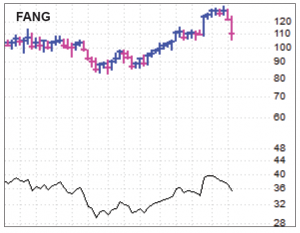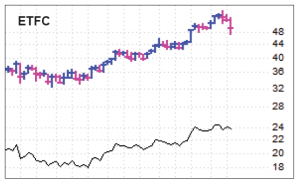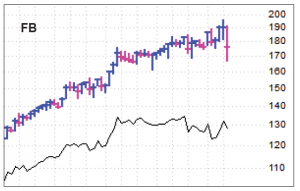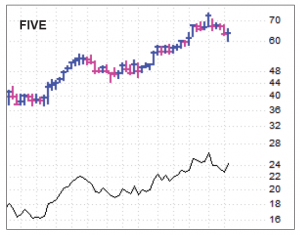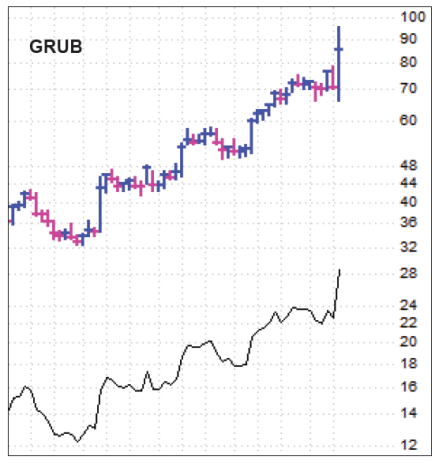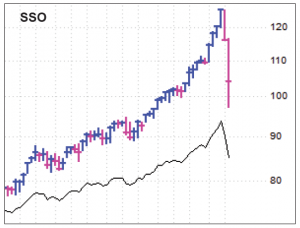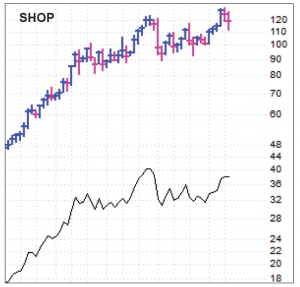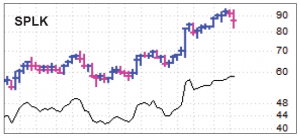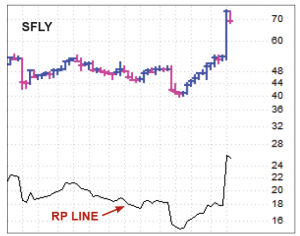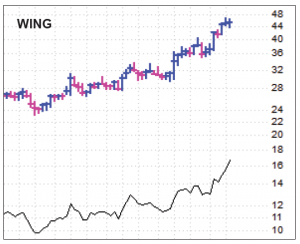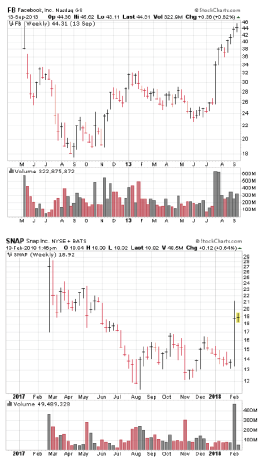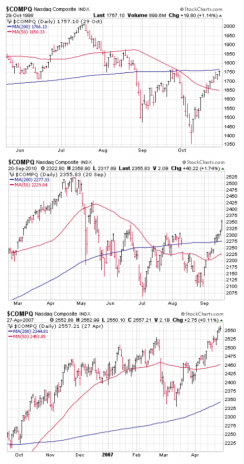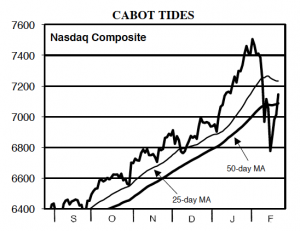After a two-week correction that prompted us to axe some stocks from the portfolio and reduce our exposure to others, markets have staged an abrupt about-face and staged a four-day rally. It’s not enough to turn our shorter-term indicators positive, but it’s a welcome relief. If the rally continues—which would be unusual given the history of similar corrections—we will change our tactics accordingly.
Cabot Growth Investor 1387
[premium_html_toc post_id="144889"]
Interpret, Don’t Predict
After a fabulous 15-month bull market run with only the tiniest of corrections, the sellers finally came out of the woodwork two weeks ago. And the pressure was intense—both the S&P 500 and Nasdaq fell nearly 12% in just 10 trading days! That led to some shorter-term exhaustion signals (479 NYSE stocks hit new lows last Tuesday, for instance), which, combined with support from the 200-day moving average, has brought about a decent bounce.
Investors are now focused on the reasons for the plunge (volatility products seem to be a popular scapegoat) and, of course, figuring out what comes next. We’re not going to spend much time on the former because there are always crowded trades that go bad when a market suddenly turns after a big run—junk bonds (2015-2016), Asian currencies (1997), garbage mortgage debt (2008) or some weird Russian ruble/U.S. Treasury pair trade (1998). That’s just what happens.
As for what comes next, we enjoy the prediction game. In the past, such a sharp, quick downturn following a prolonged run and giddy sentiment has typically led to a period of consolidation (could be a few weeks, could be longer) to wear out and scare out the weak hands. But it also leads to a resumption of the overall bull market once the selling finishes up.
That said, our job is to interpret, not to predict, because that’s what keeps us on the right side of major trends. The market’s plunge has turned our Cabot Tides bearish, which, combined with the negative Two-Second Indicator and damage among leading stocks, caused us to raise cash—from 10% two weeks ago to just north of 40% today.
At this point, we’re simply watching leading stocks and our indicators for signs the worst has passed. Should our Cabot Tides produce a new buy signal, we’ll put more money to work (encouragingly, it’s not hard to find resilient growth stocks these days, including a few we already own). If the market futzes around, we’ll mostly sit tight. And if the sellers draw blood, we’ll turn even more defensive.
[highlight_box]WHAT TO DO NOW: For now, your best move is to be patient and take your cues from the action of the market. In the Model Portfolio, we took a bunch of partial profits last week and sold both E*Trade (ETFC) and Diamondback Energy (FANG), leaving us with 42% in cash. But we’re holding our resilient performers and building a Watch List full of potential leaders of the next leg up.[/highlight_box]
Model Portfolio Update
We came into last week with just over 10% in cash, as we never went crazy on the buy side during the market’s January advance given the lack of solid entry points and the out-of-this-world sentiment we saw. Then, when the market went haywire and our Cabot Tides turned negative, we took quick action. We sold two stocks outright (Diamondback Energy and E*Trade, which had dipped back below our buy points) and took partial profits by selling one-third of our positions in four others (Facebook, Five Below, PayPal and ProShares Ultra S&P 500 Fund). Those moves pushed our cash position to around 42%.
That cash level may be a bit high, and we’d never rule out a possible nibble if we see an irresistible setup (especially if one of our stocks keels over). But we’re mostly content to bide our time until our market timing indicators improve.
Though we’re not anxious to make many moves, that doesn’t mean we’re twiddling our thumbs—the market’s weakness has made it easier to spot the potential leaders of the next advance. And the good news is we think we may already own a couple of them!
Current Recommendations
HOLD—Alibaba (BABA 187)—BABA was yanked lower along with everything else during the past couple of weeks, but while there are a few yellow flags (no net progress since mid-September), the stock is trading near its 50-day line, so is okay. The company has a bunch of irons in the fire—it inked a deal to show many of Disney’s shows on its video streaming service Youku, and Alibaba’s payment arm, Ant Financial, could be going public later this year with a monster valuation (north of $100 billion). But, to us, the real question is about the company’s spending—in Q4, earnings lifted just 25% despite sales ramping 66%. A quarter or two of that is fine, but if big spending becomes the norm, big investors may pare back. But that’s a speculation at this point. A drop to 160 would be a red flag, but we’re continuing to hold our position for now.
SOLD—Diamondback Energy (FANG 123)—The fundamental factors we’ve written about with FANG are still in place, but we sold last week for one simple reason—after holding for more than a month, our small profit vanished, so we decided to protect our capital. We still think energy stocks have likely turned the corner, though the sector might need to rest a bit with the market. If FANG (or another energy leader) shapes up in the weeks ahead, we could dive back in, but right here, we’re glad to have gotten out around breakeven.
SOLD—E*Trade Financial (ETFC 52)—It was a similar story with ETFC, which we sold last Friday because our modest profit had turned into a small loss and owning a Bull Market Stock in a sharp correction isn’t our favorite strategy. We’re still open to owning ETFC or one of its peers if/when the market’s longer-term uptrend resumes, but it all depends on how the stocks handle themselves in the weeks ahead.
HOLD—Facebook (FB 180)—We’ve owned FB for nearly five years (one of our longest holds ever!), but we’re not complacent—we sold one-third of our position late last week, partly because of the market, but also partly because FB has continued to act sluggishly (the RP line’s peak dates back to late July). Rumor-wise, there have been rumblings that the company is losing out on younger users to Snap, and it’s uncertain how the News Feed changes will affect business—analysts see earnings up just 18% this year, which would be a big slowdown compared to 77% in 2017. That said, there’s clearly big potential here from Instagram, Messenger, WhatsApp and Oculus, and the stock remains just 10% off its peak. We’re holding our remaining shares, and looking for either a push back into the mid 180s (a strong sign the uptrend is resuming) or a drop into the low 160s (which could have us pulling up stakes and moving on).
HOLD—Five Below (FIVE 65)—We also sold one-third of FIVE last week, and the plan now is to use a loose stop (in the 57 to 58 area) for our remaining shares. We still have great conviction in the company’s fundamental story, with years of expansion ahead; importantly, business shouldn’t be much affected by common fears like higher interest rates. (There were some wobbles after cuts were proposed in food stamps, but (a) we doubt that gets enacted and (b) that likely wouldn’t have much of an effect on FIVE’s customer base.) As for the stock, a push back above 68 would be a positive sign, but right here we’ll stay on Hold. Earnings are likely out near the beginning of March.
BUY—Grubhub (GRUB 93)—GRUB looks like an emerging blue chip, as the company cranks out fantastic results and big deals that are improving investor perception. Aided by its acquisition of Eat24 from Yelp, fourth-quarter sales and earnings grew 49% and 61%, respectively, while active diners rose 77% (to a huge 14.5 million). Daily average orders rose 34% and gross food sales lifted 39%. Just as important, the company announced a major nationwide delivery deal with Yum! Brands (owner of Pizza Hut, KFC and Taco Bell), with Yum investing $200 million in GRUB stock. With best-in-class logistics and technology, it’s likely more big chains will ink deals with Grubhub, especially as it’s nearly four times the size of its nearest competitor. The company’s platform handles just 2% or so of U.S. takeout orders annually today, but as ordering moves online, the potential here is gigantic if management continues to make the right moves. GRUB spiked to new highs on the news while analysts ratcheted up their estimates (now looking for 36% earnings growth this year and 33% next). The stock is sure to be volatile in the near-term, but the super strength, big story and great numbers have us going back to Buy—if you don’t own any, try to grab a few shares on dips.
BUY—PayPal (PYPL 77)—We also trimmed back on PYPL last week given the market environment and the stock’s negative reaction to eBay’s move to cut off PayPal as a payment provider. As we wrote at the time, we think the news, while not trivial, isn’t the end of the world—eBay represents 14% of PayPal’s total payment volume today, but that’s expected to decline to less than 5% by 2020, when the deal expires. (Plus, PayPal will still be a payment option on eBay through 2022, so many users will surely continue to opt for it.) Even so, the stock is back to where it initially was back in November, so we decided to take some profits and use a loose leash (in the mid-60s, near the 200-day line) for the rest.
BUY—ProShares Ultra S&P 500 Fund (SSO 111)—SSO was the fourth stock we cut back on last week, and the reason is simple: After 15 months of advancing without any meaningful correction in the S&P 500, the Cabot Tides sell signal tells us the intermediate-term trend is now pointed down. If the decline reaccelerates in the weeks ahead and causes our longer-term Cabot Trend Lines to turn negative, we’ll almost definitely sell most or all of what we have left of SSO. But at this point, the evidence still clearly favors the overall bull market being intact, so we’re content to give this leveraged long fund time to consolidate and eventually resume its major upmove.
BUY—Shopify (SHOP 137)—SHOP continues to act as if it’s ready to be a market leader again. After nosing out to new highs, the stock took a quick haircut (131 to 112!), but as soon as the pressure came off the market, shares snapped right back toward their highs. Overall, we’re optimistic, but the big hurdle is the quarterly report, which will be released tomorrow (February 15) before the market open—analysts are looking for five cents per share of earnings and revenues of $209 million (up 61% from a year ago). But the sub-metrics (gross merchandise volume, cash advance lending, etc.) and management’s forecast for 2018 will be equally important. Because of its resiliency, we’ve kept SHOP rated Buy, and if shares can get through earnings in good shape, we’d like to buy more once the market returns to health. For now, we’ll stay on Buy but will be watching the stock’s reaction.
BUY—Splunk (SPLK 92)—Our timing with Splunk couldn’t have been worse, adding the stock just before the major indexes hit the skids, but we’re pleased with how well the stock has held up, as it’s still hovering just a few percent below all-time highs. While we usually avoid the news from Washington, D.C., the recent budget deal (which boosted spending across the board) could be a big positive for Splunk, which has been making deeper inroads with Uncle Sam and should benefit from the government’s IT upgrades. Earnings are due out March 1, which will be key, but we’re optimistic, as the stock just blasted off from a gigantic consolidation in November. We’re sticking with a Buy rating, but keep new positions small until the market turns positive.
Watch List
Ligand Pharmaceuticals (LGND 157): LGND got whacked during the market downturn but has thus far found support on top of its prior base. Analysts see earnings up 41% this year and nearly 30% in 2019. Earnings will be released February 21.
Pure Storage (PSTG 22): Going way back to EMC in the late 1990s, there always seem to be a “next-generation” storage stock that enjoys a huge run as it grabs share from legacy players. And today that company looks to be Pure Storage, whose data platform is built for the world of big data, analytics and machine learning. Revenue growth is rapid and the stock is near new highs.
Snap Inc. (SNAP 20): Snap had a rough first 11 months as a public company, but last week’s Q4 report looks like a game changer, with huge sequential growth that caused the stock to go bananas. See more later in this issue.
Warrior Met Coal (HCC 31): It’s definitely cyclical, but Warrior Met Coal (previously known as Walter Coal) is benefitting from ramping production at a couple of metallurgical coal (used for making steel) mines and elevated prices. Earnings are expected to be north of $5 per share this year! Earnings are due out tonight!
Other Stocks of Interest
The stocks below may not be followed in Cabot Growth Investor on a regular basis. They’re intended to present you with ideas for additional investment beyond the Model Portfolio. For our current ratings on these stocks, see Updates on Other Stocks of Interest on the subscriber website or email mike@cabotwealth.com.
Shutterfly (SFLY 74) — Shutterfly helps consumers and businesses use photography in personalized products and services. Individuals can put their photos into photo books, stationery and greeting cards and other formats. Businesses use Shutterfly Business Solutions (SBS) to print and ship direct marketing pieces and other products. The recent surge of interest in Shutterfly (and the gap up in SFLY) stems from the company’s buyout of Lifetouch, a leader in school photography, for $825 million in cash. Lifetouch’s dominance in the school picture market (a 74% share and more than 25 million kids snapped every year) makes it a perfect addition to Shutterfly’s brand. Adding Lifetouch’s $954 million in annual revenue to Shutterfly’s $1.2 billion will nearly double raw earnings. SFLY, which had been on a roller coaster for years, gapped up to new all-time highs on the news, and if management can manage the merger well, the potential is enormous.
Teladoc (TDOC 36) — Teladoc is bringing healthcare online with a service that lets subscribers talk or video chat online with a board-certified physician and get prescriptions. The typical user is an employee of a big firm, one that values the time saved from visits to doctors’ offices. While the company has yet to turn a profit, revenue growth has been strong (59% in 2016 and 60%, 68% and 112% from Q1 to Q3 2017). Investors are interested because of Teladoc’s acquisition of Best Doctors in June 2017. The $440 million takeover brings with it a huge team of more than 50,000 top-rated medical experts, which should enhance Teladoc’s sales pitch. The proof of the pudding will come on February 27 (after the close) when the company reports Q4 and 2017 results. Analysts are expecting revenue of just over $76 million and a loss of 51 cents per share. TDOC has a long base in place, and if the news is good, a breakout above 38 would be tempting.
Wingstop (WING 46) — When Wingstop announced its Q4 and fiscal 2017 results on February 22, analysts are expecting $27.6 million in revenue and 16 cents per share in earnings. And investors are clearly expecting good things from Wingstop, a global (well, with 106 locations in eight countries outside the U.S.) chain of over 1,000 owned and franchised chicken-wing focused restaurants. Despite big increases in the cost of wings and declining same-store sales in Q4, Wingstop delivered 19% revenue growth and 31% earnings growth for the quarter. Management has big plans for expansion, both in the U.S. (135 net new openings in 2017) and around the world (where there are plans for over 1,000 locations within a few years). This might be one of the strongest retail plays around, but the reaction to that February 22 earnings report will be crucial in the near term. And even if the stock pulls back, WING has proven super resilient.
Another Big IPO Opportunity
Scanning recent IPOs is one of our favorite methods of finding potential new leading stocks, but the key to buying these stocks is patience. Our studies show that many of these IPOs come out with too much hype and fanfare, which leads to a lot of selling and underperformance, which we call the post-IPO droop.
This droop can last anywhere from a couple of months to two or three years. But the key is that, assuming the stock has sufficient trading volume and good fundamentals, these stocks are usually buyable once they experience a decisive, giant-volume rally, usually on earnings.
The classic example was Facebook (FB). Despite an overall bull market, the stock plunged for its first few months of life, and suffered another dip even after a rally. Altogether, FB had 14 months of lackluster performance. Then came the earnings blastoff in July 2013, and the rest is history. More recent examples include Alibaba (BABA), PayPal (PYPL) and Arista Networks (ANET).
Now we’re seeing what could be another post-IPO liftoff, this time from Snap Inc. (SNAP), which operates Snapchat, the camera-based app with a cult-like following. Back in 2012-2013, Facebook struggled from the perception (among other things) that it was falling behind in mobile ads, which was where the industry was clearly moving. It was only when the company released a blowout earnings report with vibrant mobile ad growth that FB kicked off its mega-uptrend.
Similarly, Snap (which had been a dud in the 11 months since it came public) has struggled with a perception that Instagram was going to beat it in the industry, that user growth was topping out and that it wouldn’t be able to monetize its user base. But last week’s quarterly report seems to have calmed a lot of those fears. Thanks to a new auction-style advertising process and a bunch of new features in its app, Q4 blew away expectations.
Not only did revenues grow 72%, but ad revenue surged 38% from the prior quarter, total users leapt 18% from a year ago, and revenue per user lifted 31%, sequentially while costs actually fell! Analysts now see revenues continuing to ramp (north of 60% both this year and next), and you can see how the stock responded last week; despite a market meltdown, SNAP soared 37% on its biggest weekly volume since coming public. (The day of earnings, the stock surged on more than 10 times average volume, which is usually a major, bullish clue.)
This is not to say that Snap is an exact replica of Facebook—Snap has yet to turn a profit, for instance, and it faces more direct competition (from Instagram) than Facebook ever did—but that doesn’t mean the company doesn’t have solid potential. SNAP is on our Watch List—if it can set up a solid launching pad by the time the market turns healthy, we could add it to the Model Portfolio. WATCH.
Watch the Cabot Tides
This past weekend we spent some time looking at a bunch of historic waterfall-like market declines, seeing what can be gleaned from them in the wake of the recent drop. Conclusion: in the near-term, the 50-day line (and our Cabot Tides) will be vital.
The first example is 1998, where the decline kicked off a short but very sharp bear market (the Nasdaq fell 33% in just 12 weeks!). The initial July retreat found support at the 200-day line, but notice how the bounce couldn’t get much above the 50-day line. The result: A much lower low in September and a retest (and undercut) in October.
The second is from 2010, when, after a huge rally over the prior 12 months, the market suffered a “flash crash” in early May before bouncing. Again, notice how the bounce was rejected by the 50-day line, leading to lower lows (about 19% off the peak) and a four-month correction and consolidation.
Finally we have the 2007 example, when the market was doing great and then, out of nowhere, plunged on fears of weakness in China’s economy (it was dubbed the Shanghai Shakeout for those who remember). The decline wasn’t quite as bad as the other two, but was still severe (7.5% in seven trading days!). Notice how the subsequent rally initially found resistance near the 50-day line but pushed above the line in April, leading to a fantastic advance through October.
So what’s the message of these and other examples we’ve examined? Really, it reinforces the value of our Cabot Tides. If the current bounce is contained by the 50-day lines of the major indexes (which would keep our Cabot Tides negative), or if the bounce is rejected before that, it would raise the odds that this correction has another down leg (or two) ahead. Right now, the 50-day lines on the S&P 500 and Nasdaq are about 2,720 and nearly 7,100, respectively.
However, should this rebound decisively leap above the 50-day line and produce a Cabot Tides buy signal, it would be a sign that the two-week shakeout is over. That doesn’t mean the market will head straight up, but will indicate that the worst is over and new leaders should begin to emerge.
Now, some might say, “Mike, that sounds too simple. What about the short volatility ETFs, interest rates and earnings reports?” Well, that’s part of the point—despite the varying fundamental factors, just sticking to the basics (Tides, etc.) does a good job of keeping you on the right side of the trend, including letting you know when the selling storm has passed.
Cabot Market Timing Indicators
The recent plunge has flipped our Cabot Tides to the bearish side of the fence, where it joins the Two-Second Indicator. The overall bull market (Cabot Trend Lines) is still intact, it’s best to hold some cash and cut back on new buying until the bulls prove they’re back in control.
Cabot Trend Lines: Bullish
Our Cabot Trend Lines remain positive, though the gap between the major indexes and their 35-week moving averages has narrowed in a big way—the S&P 500 and Nasdaq closed 2% and 3.4% above their respective trend lines last week. For a sell signal, we’d have to see both indexes close two straight weeks below their 35-week lines, which isn’t imminent. Therefore, the positive Trend Lines (and many bullish longer-term studies in December and January) tell us that the overall bull market is likely intact.
Cabot Tides: Bearish
Our Cabot Tides turned bearish early last week and remain so today, as four of the five indexes we track (excluding the Nasdaq, the daily chart of which is shown here) remain below their lower (50-day) moving averages. For growth investors, the fact that the Nasdaq is the most resilient index is a ray of light and likely a good sign for growth stocks once this correction ends. But we’ll need to see three of the five indexes back above their lower moving averages to receive a new buy signal.
Two-Second Indicator: Unhealthy
Our Two-Second Indicator is still unhealthy, with the number of new lows mushrooming during the selling spree last week before calming down some in recent days. We’ll be watching for a possible retest of the recent lows that brings far fewer new lows than last Tuesday’s peak of 479, and/or a string of sub-40 readings that tell us the buyers are back in control. Until then, the selling pressures are too high for an aggressively invested posture.
[premium_html_footer]
Send questions or comments to mike@cabotwealth.com.
Cabot Growth Investor • 176 North Street, Post Office Box 2049, Salem, MA 01970 • www.cabotwealth.com
All Cabot Growth Investor’s buy and sell recommendations are made in issues or updates and posted on the Cabot subscribers’ website. Sell recommendations may also be sent to subscribers as special bulletins via email and the recorded telephone hotline. To calculate the performance of the portfolio, Cabot “buys” and “sells” at the midpoint of the high and low prices of the stock on the day following the recommendation. Cabot’s policy is to sell any stock that shows a loss of 20% in a bull market (15% in a bear market) from our original buy price, calculated using the current closing (not intra-day) price. Subscribers should apply loss limits based on their own personal purchase prices.
Charts show both the stock’s recent trading history and its relative performance (RP) line, which shows you how the stock is performing relative to the S&P 500, a broad-based index. In the ideal case, the stock and its RP line advance in unison. Both tools are key in determining whether to hold or sell.
THE NEXT CABOT GROWTH INVESTOR WILL BE PUBLISHED FEBRUARY 28, 2018
We appreciate your feedback on this issue. Follow the link below to complete our subscriber satisfaction survey: Go to: www.surveymonkey.com/marketlettersurvey
Neither Cabot Wealth Network nor our employees are compensated by the companies we recommend. Sources of information are believed to be reliable, but are in no way guaranteed to be complete or without error. Recommendations, opinions or suggestions are given with the understanding that subscribers acting on the information assume all risks. © Cabot Wealth Network. Copying and/or electronic transmission of this report is a violation of U.S. copyright law. For the protection of our subscribers, if copyright laws are violated, the subscription will be terminated. To subscribe or for information on our privacy policy, call 978-745-5532, visit www.cabotwealth.com or write to support@cabotwealth.com.
[/premium_html_footer]




